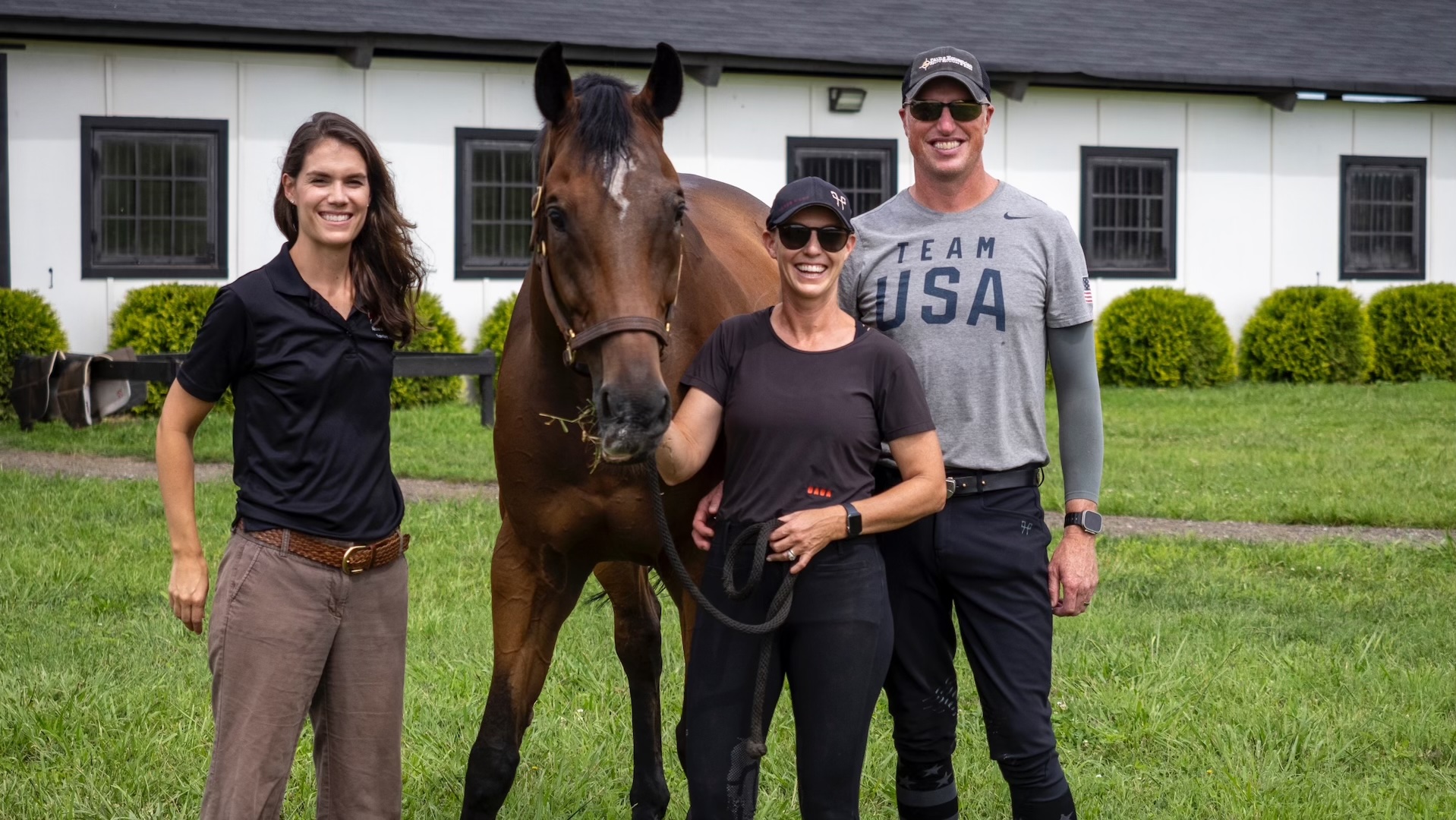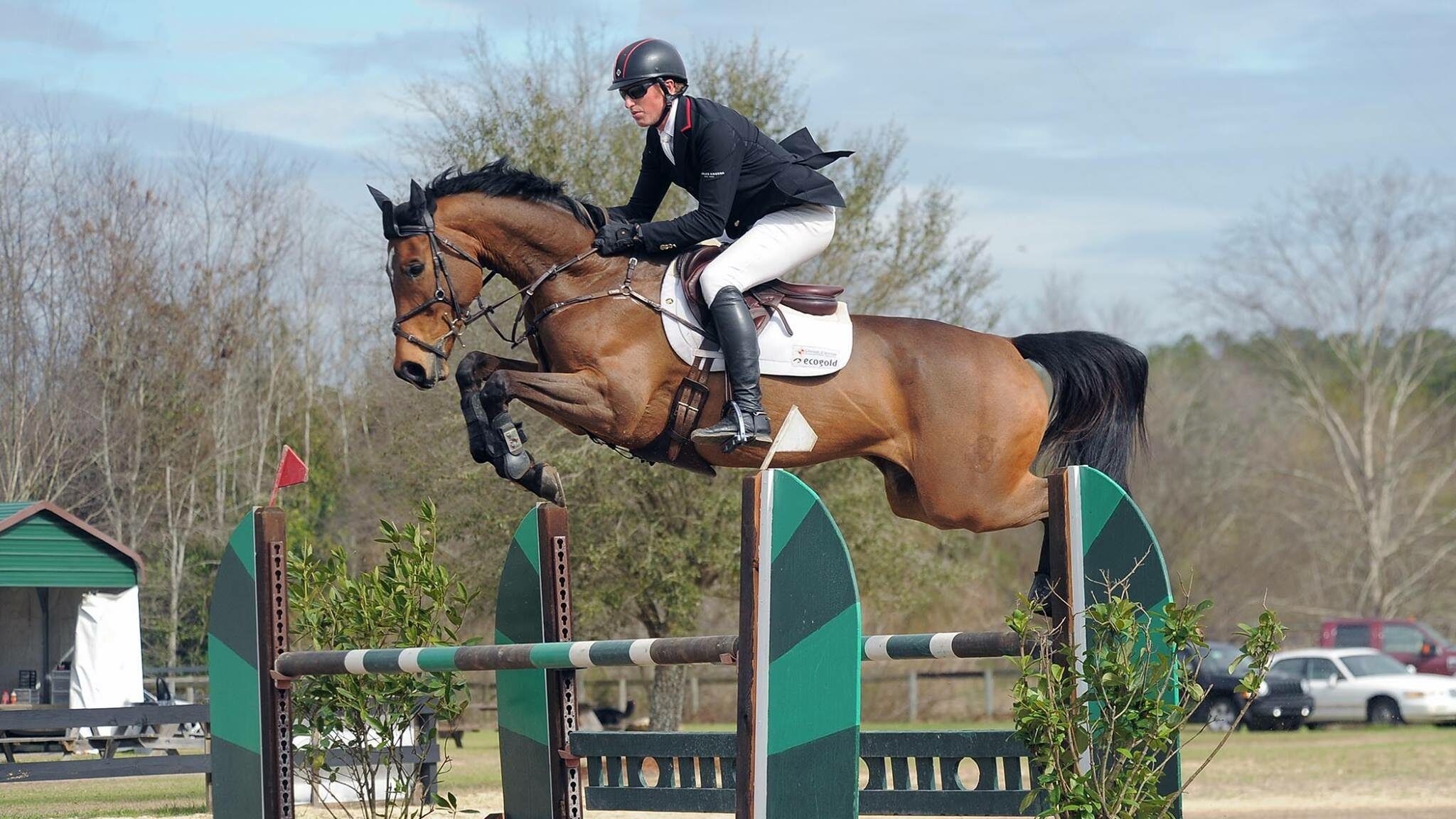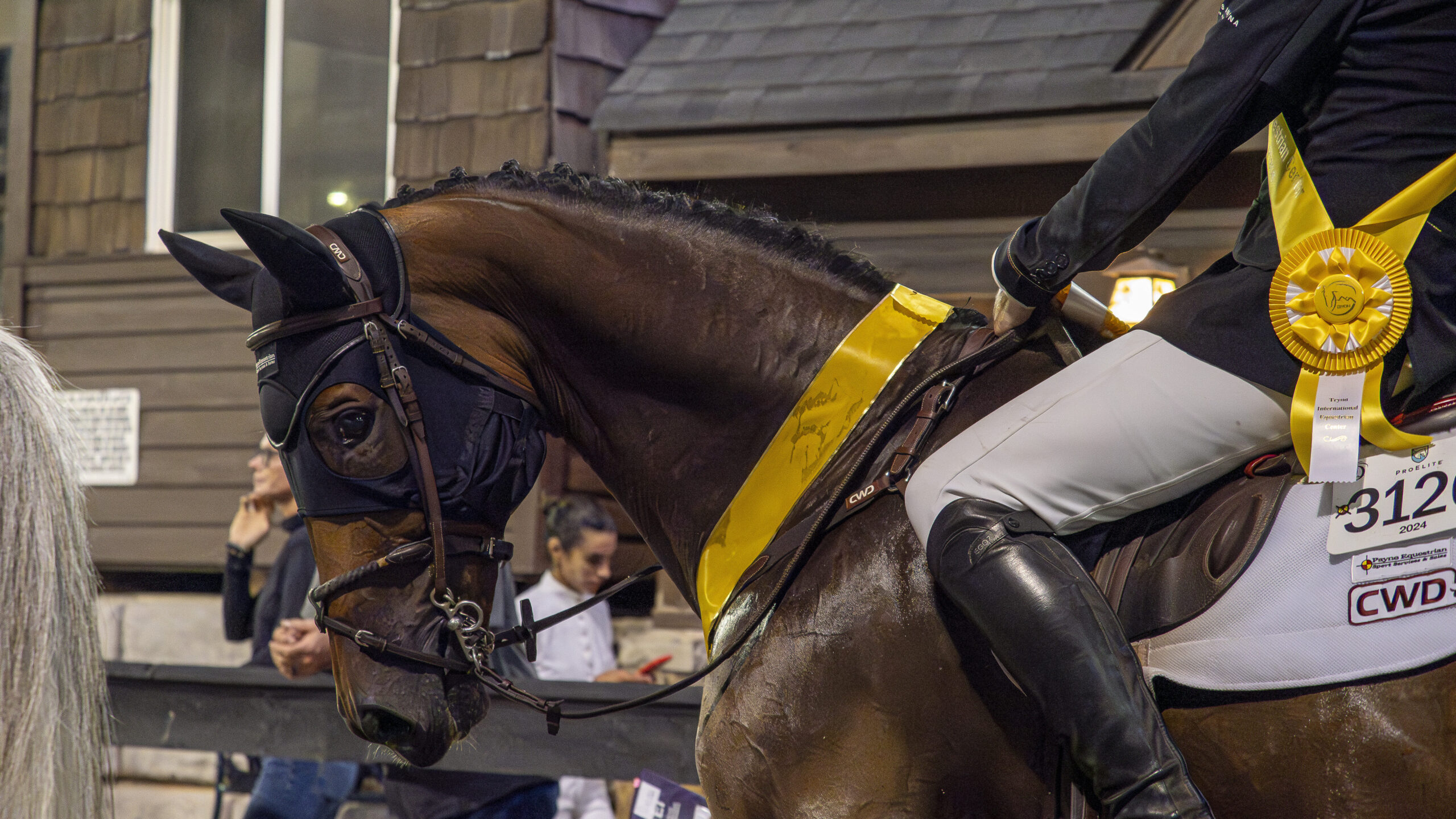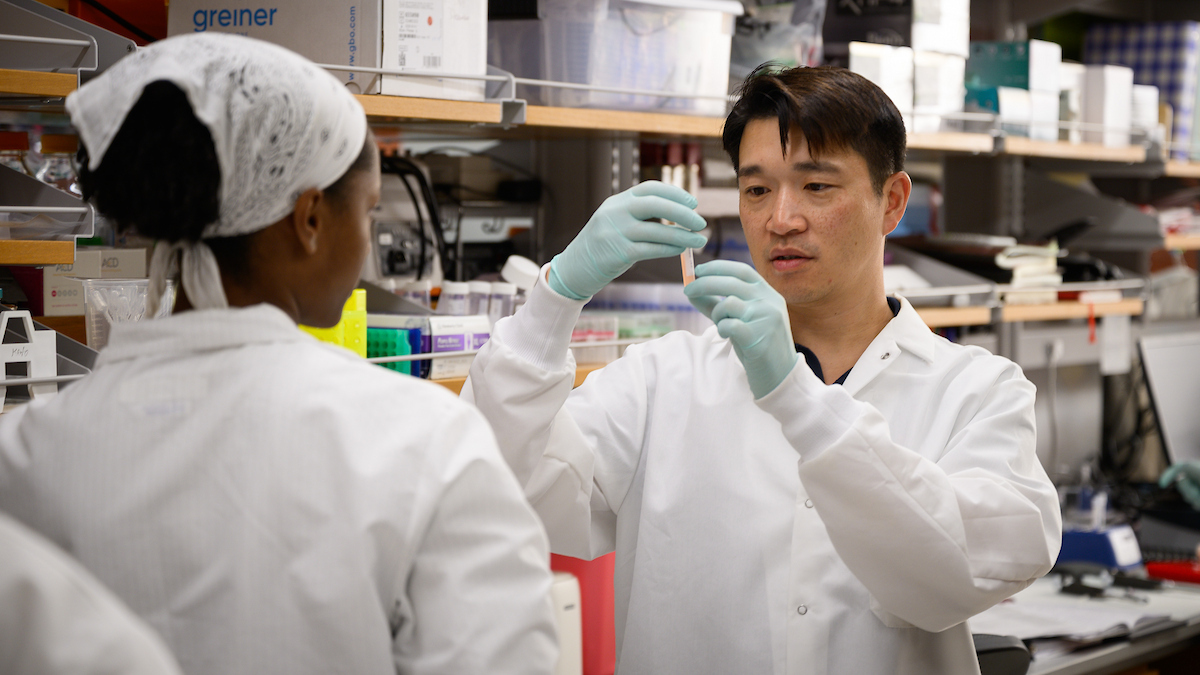NC State Equine Program Helps Olympic-Caliber Horse Get Back His Jumping JuJu
Somehow a splinter pierced a tendon in Quincy’s back right leg, and ultrasounds taken at the NC State College of Veterinary Medicine were alarming. A year of steady, state-of-the-art treatment, however, has left the elite equine even better than before.

How Quincy the show jumping horse severely injured his leg while being transported around Ocala, Florida, during a $100,000 Grand Prix event in spring 2023 remains a mystery. It’s clear, however, how he recovered enough to compete and remarkably place fourth in the same event in 2024.
His owners, Doug and Jess Payne of Rougemont, North Carolina, have spent the past year working with NC State’s equine sports medicine team to return Quincy, whose full name is Quintessence, to his Olympic-caliber condition. Through a patient-centered rehabilitation treatment plan overseen by clinical veterinarian Dr. Caitlyn Redding Horne, the 13-year-old horse has even surpassed his previous peak.
Next month, Quincy will jump in his first five-star event, the highest level of competition for jumping horses.
“Dr. Horne is awesome, super analytical,” says Doug Payne, who with his wife is training about 25 elite horses on their 30-acre farm in Orange County. “The core treatment group has no ego about it, that their way is the only way. To be flexible like that is incredibly helpful and so important for the long-term health and success of the horses we have.”
At the event in Florida last year, Quincy completed the first day of jumps, but the next morning he clearly wasn’t himself. The couple noticed a small bump on a back leg that looked as if it could be a splinter and speculated that he had kicked a wall during the night.
“But there’s no telling — he’s a horse,” Jess Payne says. “That tiny little splinter in his tendon, though, compromised the whole back leg.”
‘Oh, No’
When they returned to North Carolina, the Paynes had Quincy seen at the NC State College of Veterinary Medicine. Both Horne, who received her undergraduate and DVM degrees at NC State, and her father, Dr. Rich Redding, a retired clinical professor of equine orthopedics and lameness at NC State, inspected the horse’s ultrasound images.

“They looked at the images and said, ‘Oh, no,’ and we were, like, ‘Great,’” Jess Payne says. “Nobody got the warm and fuzzies about this leg. We did every single thing they recommended, stem cell therapy, laser treatments, shock waves. Everything.”
Fortunately for the Paynes and other horse owners in North Carolina and beyond, the NC State College of Veterinary Medicine can offer about everything.
Since the American Veterinary Medical Association provisionally recognized veterinary sports medicine and rehabilitation as a speciality about a decade ago, NC State has built a program known for state-of-the-art equipment and board-certified clinicians who are also spearheading research that is changing lives. The field officially became recognized as the American College of Veterinary Sports Medicine and Rehabilitation in 2018.
About two weeks into his recovery at NC State, Quincy received bone-marrow-derived stem cell therapy pioneered by Dr. Lauren Schnabel, professor of equine orthopedic surgery.
Getting tendon injuries to heal in any species is difficult, and reinjury rates are high. In a JAVMA One Health commentary published in October, Schnabel discussed the benefits of stem cells for tendon healing and particularly for the treatment of superficial digital flexor tendon injuries like Quincy had. The commentary also highlighted the work that the Schnabel Laboratory is doing to further optimize stem cells by stimulating them to secrete factors particularly important for tendon healing.
“Stem cells don’t necessarily get them back faster, but they’re less likely to reinjure and they heal better long term,” says Horne, who was NC State’s first resident in equine sports medicine in 2016. “A yearlong rehab time for Quincy was a very normal rehab time, and the fact that he is back competing successfully is very encouraging, especially with the extreme injury he had.”

Much of Quincy’s treatment has been a matter of not letting him do too much too fast. Horne has carefully monitored his progress — and his mental health — through long-term stall rest, short walks, laser treatments, slow running then jumping, gradually increasing in intensity.
“Half of our job during the rehab is their minds,” Horne says. “These are athletes. They like to be competing, so we have to be creative. We design a plan unique to each individual horse, where they’re at, what they need, because not every client can handle the same amount of involvement and engagement.”
One thing Quincy didn’t do when it was time to get him back on his feet was submit to hand-walking. Jess Payne, who describes her favorite horse as “full of character,” rode him slowly and safely as he regained his agility.
The word Doug Payne uses for Quincy is exceptional.
Olympic Realities and Dreams
In his younger days, Quincy won both the six-year and seven-year finals in events organized by age bracket. The Paynes say that feat is unusual, given that his competitors would have been horses tracking toward international or Olympic success.
High-performance horses typically peak between the ages of 10 and 18, the Paynes say, so Quincy still has plenty of time to qualify for the Olympics in 2028. When the horses that just competed in Paris in 2024 return to competition, they will be Quincy’s peers.
“Once you’re at the highest of the sport, there’s only so many horse shows you can go to,” Jess Payne says. “A lot of stars have to align, but he certainly would have the physical abilities to go to the Olympics if everything else falls into place. It’s a right time, right place, right year type of thing.”
The Olympics are not just a dream for the Paynes. Doug, whose mother was an equestrian judge in two Olympic games, rode a horse he partly owned to the highest finish of any American equestrian in Tokyo four years ago. Jess, an Auburn University graduate with dual Canadian citizenship, has been on the short list to ride in the Olympics on the Canadian team more than once.
Inside the beautiful barn on the Payne farm, an Olympic flag hangs.
The Paynes, who both grew up outside North Carolina in horse-riding families, bought the farmland about 10 years ago after combing the East Coast for the perfect spot to eventually build their business Payne Equestrian. Some of the 25 elite horses now on the property they own, some they own with partners and a few belong to North Carolina clients. In competitions, Doug Payne rides the horses.
Being near the NC State College of Veterinary Medicine was a factor in their location decision, say the Paynes, who moved from New Jersey. Now, Quincy’s amazing recovery has put the exclamation point on how happy they are to be in North Carolina and to have access to NC State and experts like Horne.
“I’m forever grateful that she has the passion for these horses and wants to get to the top level as much as we do,” Jess Payne says. “She did all the research on the best way to get this horse back in the fastest amount of time, and that’s invaluable. To have somebody like that on your team is pretty incredible.”



